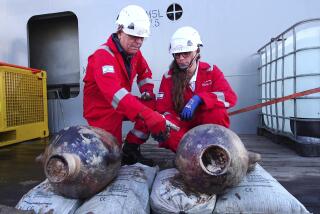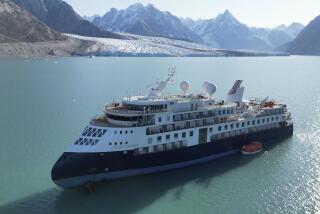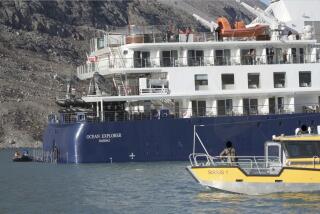Shell’s Arctic drilling rig runs adrift in Alaskan harbor
SEATTLE — Shell’s Arctic oil ambitions ran into new problems Saturday evening when the Discoverer drilling rig, slated to begin exploratory operations in the Chukchi Sea next month, ran adrift in stiff winds in Alaska’s Dutch Harbor and came perilously close to the beach.
The vessel ‘s anchor failed to hold and the 514-foot ship began drifting, but its movement was halted when tug boats were called in to assist, Coast Guard spokeswoman Sara Francis told the Los Angeles Times.
“We don’t know exactly what happened yet. We do know that the vessel’s anchor didn’t hold, they began to drift, they let out more anchor chain to slow that drift and called for immediate tug assistance,” Francis said.
Photos shot by residents of the large fishing port in the Aleutian Islands show the Discoverer heart-stoppingly close to the beach, but Francis said the initial investigation suggests it did not actually ground on shore.
“It went extremely close, but the crew did not feel themselves impact anything, or feel the vibrations you feel when a vessel grounds,” she said.
Dutch Harbor boat captain Kristjan Laxfoss, who was out on the beach as the vessel neared it, said it was clear to him that the ship had struck ground.
“The stern was on ground, there’s no question about that. I think everybody that was down there knew that,” Laxfoss said in a telephone interview.
He said the beach was mostly rocks and gravel, but there are a few sandy spots that might have softened the impact. “It’s what, a 500-foot ship? You might not feel anything if you go very slowly up on the beach.”
Francis said divers were en route Sunday morning to inspect the hull to determine whether there was any damage.
Shell spokesman Curtis Smith said the vessel veered “very near the coast,” and divers should be in position by Monday morning for detailed inspections. Company staff is now trying to determine what made the vessel come loose from its moorings, he said.
The company has been dealing with an array of last-minute problems as it prepares for its first offshore drilling in the Arctic in two decades. The company last week had to apply for a change in its air permit for the drill bit generator on the Discoverer when the generator failed to meet tough EPA requirements for nitrogen oxide and ammonia emissions.
And Shell is still trying to win U.S. Coast Guard certification for its oil-spill response vessel, the Arctic Challenger, which is still moored in Bellingham, Wash., finishing lengthy renovations.
Sources familiar with the overhaul of that vessel said engineers are redesigning the strut supports for the flare boom assembly — with which natural gas extracted from an oil spill would be flared off — and attempting to finish installing high-pressure hose onto the vessel’s storage reels. Sea trials are now set for July 23.
Once those are complete, the Arctic Challenger can begin steaming north, either directly to the Arctic or to join the rest of Shell’s drilling fleet midway in Dutch Harbor, where the vessels are awaiting the dissipation of late-winter ice still lodged farther north.
Coast Guard officials said the weather around the Discoverer was improving. Winds on Sunday were forecast to decrease to 11 miles per hour with seas of four feet and rain — a typical, balmy Dutch Harbor summer day.
More to Read
Sign up for Essential California
The most important California stories and recommendations in your inbox every morning.
You may occasionally receive promotional content from the Los Angeles Times.










